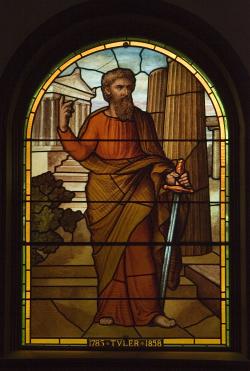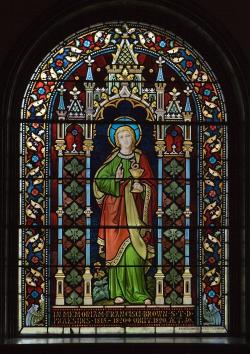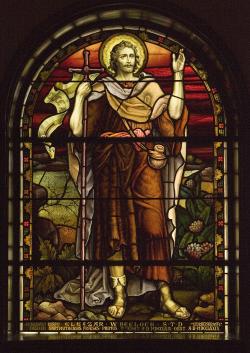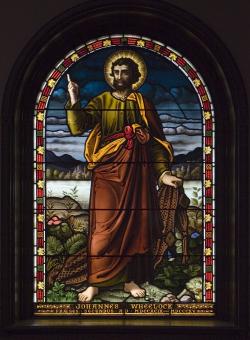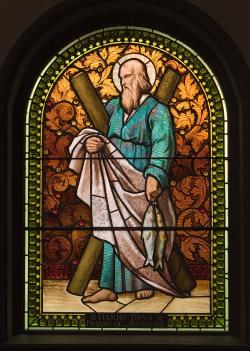There are no official records found regarding window #5, as it was not in place when the chapel was dedicated. Since the windows were uncovered, an inscription at the bottom reveals that this window is a memorial to President Daniel Dana. We have no information about its maker or donor. Mr. Greg Gorman, a stained glass expert from Lyme, NH believed this window was of St. Andrew. Judging from the glass which we can see, this makes sense for a number of reasons.
First, the cross which is behind the central figure depicted is a decussate (sideways, in the shape of an X cross, ) singularly known to be that of St. Andrew. Secondly, it is believed that Andrew was bound, not nailed to his cross. The depicted figure does not have any signs of nail pierced hands or feet. "It is generally agreed that he was crucified by order of the Roman Governor, Aegeas or Aegeates, at Patrae in Achaia, and that he was bound, not nailed, to the cross, in order to prolong his sufferings. The cross on which he suffered is commonly held to have been the decussate cross, now known as St. Andrew's, though the evidence for this view seems to be no older than the fourteenth century." Finally, the figure in window #5 is holding two fish. Andrew was a fisherman when Jesus called him as a disciple, although he was not the only disciple who was a fisherman.
When Jesus decides that the multitude must be fed, it is the disciple Andrew tells Jesus of the boy who has two fishes. Jesus then feeds the crowd of 5,000, performing one of the more notable miracles of his ministry. Mark 1:16-18 "Now as he walked by the sea of Galilee, he saw Simon and Andrew his brother casting a net into the sea: for they were fishers. And Jesus said unto them, Come ye after me, and I will make you to become fishers of men. And straightway they forsook their nets, and followed him." John 6:5-9a "When Jesus then lifted up his eyes, and saw a great company come unto him, he saith unto Philip, Whence shall we buy bread, that these may eat? ...One of his disciples, Andrew, Simon Peter's brother, saith unto him, There is a lad here, which hath five barley loaves, and two small fishes:" It is profoundly unlikely that any Christian figure other than Andrew would have all of the stated characteristics. Especially because of the presence of the decussate cross, the identity of the figure in window #5 is almost certainly St. Andrew.
